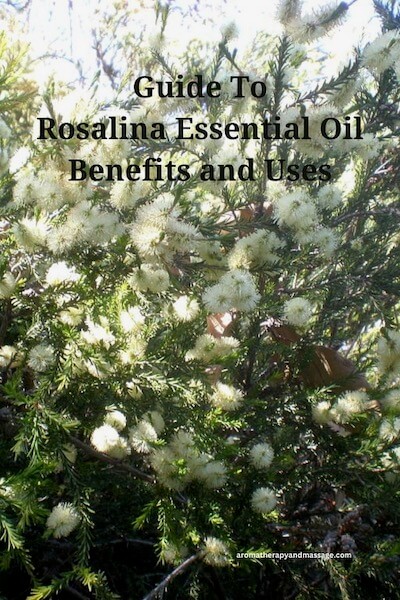“Rosalina is an ethereal healing presence, gentler than tea tree but just as useful,” states Working With Unusual Oils. Rosalina essential oil (Melaleuca ericifolia) is also known as lavender tea tree, sweet tea tree, or swamp paperbark essential oil.
Plant family: Myrtaceae
Production: Steam distilled from the leaves of the Melaleuca ericifolia tree.
Aroma: Fresh, slightly camphorous, floral.
Perfume/Aromatic note: Top
Is
rosalina safe to use during pregnancy? Yes, according to Plant Therapy. Consult a
professional for specifics.
Is rosalina essential oil safe for
children? Yes, for kids over age six months, according to several sources. Rosalina is often used to replace tea tree oil when that
oil might be too strong for a child.
Main components:
- linalool 35.0–55.0{c83b96b267e11f12aa2387b40a42d69d65b4fa2fbc0f29beedb0c76e3b50b2dc}
- 1,8-cineole 18.0–26.0{c83b96b267e11f12aa2387b40a42d69d65b4fa2fbc0f29beedb0c76e3b50b2dc}
- alpha-pinene 5.0–10.0{c83b96b267e11f12aa2387b40a42d69d65b4fa2fbc0f29beedb0c76e3b50b2dc}
Source: Essential Oil Safety, 2nd Edition
Rosalina Aromatherapy Benefits
The Heart of Aromatherapy: “Rosalina is a good choice when you want the cleansing, therapeutic action of tea tree, but feel tea tree may be too strong.” This essential oil has the following uses:
- Respiratory support
- Soothing allergies and sinus congestion
- Clearing mucous and congestion
- Easing sore throats and coughs
- Calming inflammation
- Making natural cleaning blends
- Feeling relaxed and uplifted
The Complete Book of Essential Oils and Aromatherapy: Use rosalina for respiratory support, sinus headache, coughs, colds, restlessness, nervousness, acne, pimples, and insect bites.
Aromatica: A Clinical Guide to Essential Oil Therapeutics, Volume 2: Rosalina’s general character is relaxing, making the oil useful for stress-related disorders, insomnia, mild anxiety, and similar conditions. This essential oil helps clear respiratory congestion. The oil is particularly useful for children’s congestion problems when a child is irritable, has sleeping problems, and experiences anxiety. You can also use the oil to help heal boils, acne, herpes, tinea (skin fungus), and insect bites.
Plant Therapy: Rosalina can help relieve allergies, uplift emotions, support the immune system, and create a calming atmosphere. This essential oil is useful during times of irritability or restlessness. The oil may also help relieve insect bites or irritated skin.
Working With Unusual Oils: Rosalina may help clear acne, boils, herpes, nail fungus, and cold sores. This essential oil is useful for the respiratory system, joint pain, and muscle aches. The oil also calms and relaxes the nervous system and may promote sleep and relieve restlessness while also having uplifting properties. To make a gel to use on cold sores, blend 2 drops rosalina and 2 drops manuka essential oil into 10 ml (about 2 teaspoons) aloe vera gel.
The Complete Guide to Aromatherapy, Third Edition, Vol. 1: Suggested essential oils for rosalina blends:
- To relieve muscle aches and pains: black pepper, Fragonia, kunzea, ginger, peppermint, or rosemary.
- To reduce anxiety, stress, and nervous tension: bergamot, atlas cedarwood, geranium, lavender, sweet orange, neroli, or sandalwood.
- To relieve cold and flu symptoms: eucalyptus (either lemon-scented or 1,8 cineole), Fragonia, spike lavender, lemon, tea tree, or thyme.
- To reduce acne: bergamot, lavender, or tea tree.
Aromatherapeutic Blending: Suggested essential oils to blend with rosalina:
- For general respiratory support: cypress or frankincense.
- To relieve respiratory congestion: Eucalyptus globulus, rosemary, or thyme.
- To reduce coughing: sweet fennel or thyme.
- Allergy relief: sweet marjoram.
Rosalina Essential Oil Uses and Blends
Foaming Hand Soap
Add to a 50-ml foam soap pump bottle:
- 40 ml (1.4 ounces or 2.8 teaspoons) castile soap
- 8 drops rosalina
- 8 drops tea tree essential oil
- 8 drops lavender essential oil
Bath Salts for Muscle Aches
- 1 teaspoon vanilla-infused jojoba oil
- 2 drops rosalina
- 3 drops lavender essential oil
- 2 ounces (4 tablespoons) salt
Blend jojoba and essential oils. Stir in salt. Swirl blend into bath water and enjoy. Source: The Heart of Aromatherapy
DIY Vapor Rub
- 5 ounces (about 10 tablespoons) beeswax
- 5 ounces coconut oil (solid)
- 20 drops Eucalyptus dives essential oil
- 10 drops rosalina essential oil
- 6 drops cypress essential oil
- Tin containers
- Using a double boiler, melt the beeswax and coconut oil.
- Remove mixture from heat and quickly stir in essential oils.
- Pour mixture into tins and let cool fully.
This rub has a one-year shelf life when stored in a cool, dark place.
Source: Plant Therapy
Blends for Children
Allergy Relief Inhaler for Kids
For children five years and older.
- 3 drops rosalina
- 3 drops cedarwood (Cedrus atlantica) essential oil
- 4 drops lavender essential oil
Drop the essential oils onto the organic cotton wick of an aromatherapy inhaler. The child can use the inhaler as needed.
Caution: If headache or nausea occurs, lessen or discontinue use.
Source: Amy Emnett, “Aromatherapy for Seasonal Allergies in Children,” NAHA Aromatherapy Journal, Spring 2017.1 , p. 63.
Sniffle Stop Inhaler
- 6 drops rosalina
- 6 drops (red) cedarwood (Juniperus virginiana) essential oil
- 6 drops juniper berry essential oil
Add up to 18 drops of the blend to the cotton wick of an inhaler.
Source: Amber Duncan, Clinical Aromatherapist, “School and Essential Oils” NAHA Aromatherapy Journal, Autumn 2016.3, p. 10.
Vapor Rub for Kids
For children five years and older to help break up congestion and ease coughing.
- 1/2 cup coconut oil
- 2 tablespoons grated beeswax
- 10 drops rosalina
- 5 drops fir needle (Abies sibrica) essential oil
- 5 drops lavender essential oil
- Salve tins or jar
- In a double boiler over low heat, melt the coconut oil and beeswax.
- Remove mixture from heat and immediately stir in the essential oils.
- Pour the mixture into small glass jars or salve tins.
To use: Rub a dime-size amount onto the chest, neck, and upper back.
Source: Jaime Vinson, BSN, RN, HN-BC, RYT, “Combating the Common Cold with Aromatherapy and herbs,” NAHA Aromatherapy Journal, Winter 2019.4, p. 10.
Photo Credit: Consultaplantas, CC BY-SA 4.0, via Wikimedia Commons
